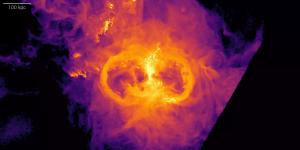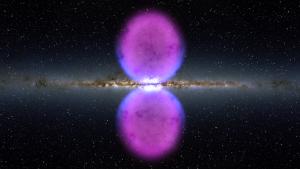Blog
Out of the Ashes
16 June 2021
 TNG Collaboration/Dylan Nelson
TNG Collaboration/Dylan NelsonBlack holes are the most powerful destructive forces in the universe. They can rip apart a star and scatter its ashes out of the galaxy at nearly the speed of light. But these engines of destruction can also pave the way for new stars to form, as a new study in Nature shows.1
The study looks at the question of why some galaxies actively create stars, while others do not. For example, in the Milky Way galaxy, new stars form at an average rate of 1 - 2 per year. Other galaxies, known as starburst galaxies, have extremely active star-producing regions. But in some galaxies, there is almost no star production. These “quenched” galaxies are often smaller satellite galaxies to larger galaxies.
It’s generally thought that satellite galaxies are often quenched because they are more susceptible to intergalactic wind. This diffuse intergalactic gas can flow through these small galaxies, clearing them of gas and dust, thus removing the material needed to produce new stars.
 NASA Goddard
NASA GoddardSince these small galaxies often orbit larger ones, they would also be affected by the flow of gas from active supermassive black holes within the main galaxy. The team figured that satellite galaxies passing through the flow region of the black hole would be more quenched than those outside the flow since the flow of a black hole should be more effective at clearing matter from the satellite galaxy. But when they looked at the star production of these galaxies, they found it was slightly higher for regions in the flow. It turns out that supermassive black holes actually help increase star production in satellite galaxies.
Based on computer simulations, the team thinks they know why. An active supermassive black hole can clear gas and dust from a region, and this creates low-density regions, or bubbles, near its galaxy. These bubble regions have an even lower density than the surrounding intergalactic regions. So if a satellite galaxy is within this bubble, less of its gas and dust is stripped away, and it can produce stars more easily.
This study is a great example of the complexity of galactic dynamics, and how the behavior of one galaxy can affect the creation of stars in another. It’s also a good example of testing your hypotheses, even when you think the answer is obvious. Sometimes the answer is completely unexpected, and that’s when we can learn the most.
Martín-Navarro, Ignacio, et al. “Anisotropic satellite galaxy quenching modulated by black hole activity.” Nature 594.7862 (2021): 187-190. ↩︎